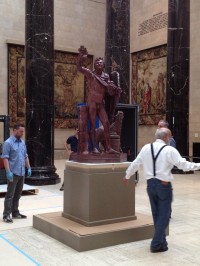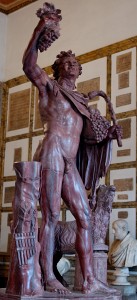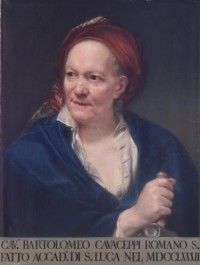 A striking Roman statue from the 2nd century A.D. has crossed the Atlantic for the first time. On loan from Rome’s Capitoline Museum, the Fauno Rosso or Red Faun is now on display at Kansas City’s Nelson-Atkins Museum of Art. The museum has kitted out its Kirkwood Hall to look like a Roman palazzo with the Faun (it’s actually a satyr since it was originally Greek and it doesn’t have goat legs) as its centerpiece.
A striking Roman statue from the 2nd century A.D. has crossed the Atlantic for the first time. On loan from Rome’s Capitoline Museum, the Fauno Rosso or Red Faun is now on display at Kansas City’s Nelson-Atkins Museum of Art. The museum has kitted out its Kirkwood Hall to look like a Roman palazzo with the Faun (it’s actually a satyr since it was originally Greek and it doesn’t have goat legs) as its centerpiece.
The Fauno rosso depicts a satyr, follower of Dionysus, the god of wine. The entire sculpture is of red marble, rather than the commonly used white marble, and seems to suggest that the subject is so drunk that his skin has turned into the color of the grapes. To his left is a goat that looks up at him and rests one leg on a wicker basket. The Fauno rosso’s eyes would have been of glass or brilliant stone (the sockets have been hollowed out to receive them) and would have been sparkling with life and energy.
Art historians believe it’s a Roman copy of a late Hellenistic Greek original, probably a bronze. Given its find spot — on the site of the small palace of Hadrian’s Villa in Tivoli, it’s likely the sculpture was commissioned by the Emperor Hadrian himself. The artists are thought to have been Aristeas and Papias of Aphrodisias who made and signed two other famous sculptures, the Young Centaur and the Old Centaur, discovered on the site and now also in the Capitoline Museum.
 The Red Faun was unearthed by Monsignor Giuseppe Furietti, an antiquarian who secured digging rights to the small palace site, in 1736. (Furietti also found the Centaurs that same year in the same area.) It was far from complete. All that was found of the original Faun was the head, the nude torso, a partial left arm, the torso of the goat, some of the fruit on the draped cloak (called a nebris), one thumb and a fragment of the basket. Although Furietti had incurred Pope Benedict XIV’s eternal wrath when he refused to give him the Centaurs, he did give him the Red Faun. The Pope would donate it to the newly opened Capitoline Museum in 1746, but before it was ready to go on public display, it obviously needed a lot of work.
The Red Faun was unearthed by Monsignor Giuseppe Furietti, an antiquarian who secured digging rights to the small palace site, in 1736. (Furietti also found the Centaurs that same year in the same area.) It was far from complete. All that was found of the original Faun was the head, the nude torso, a partial left arm, the torso of the goat, some of the fruit on the draped cloak (called a nebris), one thumb and a fragment of the basket. Although Furietti had incurred Pope Benedict XIV’s eternal wrath when he refused to give him the Centaurs, he did give him the Red Faun. The Pope would donate it to the newly opened Capitoline Museum in 1746, but before it was ready to go on public display, it obviously needed a lot of work.
In 1744, Marchese Capponi, the first director of the Capitoline Museum, commissioned two young Roman sculptors, Clemente Bianchi and Bartolomeo Cavaceppi, to make a showable sculpture out of the pieces. Thanks to the Vatican’s most wonderful habit of hoarding all its paperwork, we still have the invoice showing what each of them did. They were both paid the same amount, but Bianchi was in charge of carving the hard red marble — a material chosen by the Romans for its expense and difficulty rather than its suitability for sculpture — while Cavaceppi made the preparatory models, casts of the missing pieces and polished and cleaned the finished product.
 It was Cavaceppi, therefore, who would go on to become the premiere restorer of 18th century Rome, who designed and cast the base, arms, legs, the shepherd’s pipe to the Faun’s right that doubles as support for the trunk, the goat and the basket to the Faun’s left. The marble used for the new parts was a close match in color (although it had to be stained to match the patina of the ancient pieces), but it has very noticeable thick grey veins running through it. Caveceppi also deliberately added cracks and nicks to integrate the new marble into the old.
It was Cavaceppi, therefore, who would go on to become the premiere restorer of 18th century Rome, who designed and cast the base, arms, legs, the shepherd’s pipe to the Faun’s right that doubles as support for the trunk, the goat and the basket to the Faun’s left. The marble used for the new parts was a close match in color (although it had to be stained to match the patina of the ancient pieces), but it has very noticeable thick grey veins running through it. Caveceppi also deliberately added cracks and nicks to integrate the new marble into the old.
This process was not restoration the way we think of it today. With so many parts of antique sculptures coming to light (300 sculptures were found at Hadrian’s Villa alone), many of them inscrutable body parts — artists in the 18th century put them together however they wanted. The identity of the original statue, which person or deity it had represented, was not any kind of priority. Embellishments and reconfigurations, some of them highly questionable, were the order of the day.
In other words, we have no idea what the Red Faun looked like when it was made in the 2nd century A.D. or what the late Hellenstic bronze, looked like. If you’re fortunate enough to be able to see him in Kansas City, look for those grey stripes in the marble to distinguish between original and 18th century parts.
Am I a copy of a earlier now lost original?
He’s a beautiful piece of art. I’m lucky enough to volunteer at the museum in Kansas City and have enjoyed his stay here. I’ll miss him.
How wonderful to have had the opportunity to hang out with the Red Faun. Did visitors enjoy his stay as well?